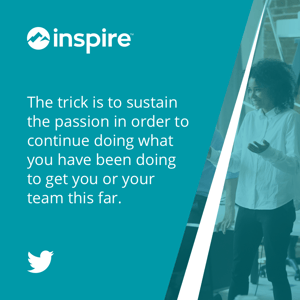“You have to have confidence in your ability, and then be tough enough to follow through.”
— Rosalynn Carter
We’ve all experienced moments where we’ve been “In the Zone.” A moment where we are so dialed in on a task or event, we are engaged in that we lose track of time and space. Perhaps, during a sports competition where everything is clicking, and you excel at such a high level that you transcend your physical abilities and achieve a level of performance that exceeded your expectations. Alternatively, perhaps you are playing an instrument and lose yourself in the lyrics and melody and become a part of the music. While these moments don’t happen all of the time, or often enough, they are not a result of luck or random fate. Achieving high performance does not come easy; it is a result of building the mindset and skill set over time to excel to the best of your abilities.
Reaching the Achieving Phase of #Performance only happens when we effectively navigate the phases that lead up to this state. Find out more from @InspireSoftware. Tweet this!There is a movement in positive psychology that is revealing various mental and physical elements involved in what is defined as the flow state. The flow state is also a known colloquially for being “in the zone.” Flow is the mental state of operation in which a person performing an activity is fully immersed in a feeling of energized focus, full involvement, and enjoyment in the process of the event. In essence, flow is characterized by complete absorption in what one does, and a resulting loss in one's sense of space and time. It often results in high levels of personal performance.
Flow state may be possible for athletes and artists, but can we achieve flow state at work? The authors of Achieve Leadership Genius believe that leaders at every level of an organization can experience high standards of work passion and excellence through a series of predictable, and manageable phases, or states, of performance toward a goal.
“There are natural ebbs and flows of Ability and Energy when you pursue a goal,” says best-selling business author, and CoAuthor of Achieve Leadership Genius. Susan Fowler. “If you aren’t aware of these predictable phases, you can lose your way during the journey toward your intended destination.”
When we get lost and unfocused in the performance process, we experience frustration and dissatisfaction with our work. So how do we get to a place where we can experience the highest levels of performance and productivity?
The Journey to Achieving High Performance
No individual or team jumps straight to achieving a flow state. High performers continually and intentionally assess their performance throughout their journey toward a goal, as they experience and engage variable levels of energy and ability during the pursuit of the objective they are attempting to achieve. It’s a process that is experienced through a series of phases and practices before arriving at the phase of High Energy and High Ability.
“The mistake people most often make is assessing their ability toward a goal, is that they believe it’s actually higher than it is in reality,” says Dr. Drea Zigarmi, Coauthor of Achieve Leadership Genius. “People naturally assume that they can transport skills that they’ve used on past goals, even if they are similar to the goal they are currently pursuing, and that it will automatically help translate into high performance on the new objective. This simply isn’t the case.”
Individuals and teams are initially curious about the possibility of accomplishing their goals when they first begin to pursue them. They quickly discover that they need to confront the challenges that inevitably occur during the process of trying to work toward an objective. If successfully navigating the Confronting Phase of Performance, individuals and teams proceed with caution toward the end goal by pitching solutions to problems and carefully listening to one another when their energies and abilities fluctuate toward the end goal. Once you or your team has worked their way through the first challenging and uncertain phases of a goal, they may be ready to arrive at the Achieving Phase of Performance.
Find out why managing individual & team energies and abilities are critical to achieving your organization's most important #goals while increasing #EmployeeEngagement. @InspireSoftware Tweet this!The Achieving Phase of Performance
The Achieving Phase of Performance is when you or your team’s energies and abilities are both high and happens when we effectively navigate the phases of performance that lead up to this state. Engaging our energies and skills effectively through each phase, to make physical and psychological progress toward a goal is necessary before elevating our performance to a flow state. If needs are not engaged when an individual or team’s ability to achieve a goal is low, or if there are assumptions that your transferable skills will enable you or your team accomplish the goal right away, then you run the risk of rushing the process and miss some of the most critical learnings in discovered in the journey toward the objective.
During the Achieving Phase of Performance, and individual or team ’s performance has increased, and team members relationships have strengthened. These relationships are marked by authentic exchanges that are both confrontational and collaborative. Your outcomes are being met, and new ideas are sorted through and used based on individual contributions to a shared vision and goal. The conflict the team may have had in the early stages of this journey has helped them grow, and trust has increased as they get smarter about the end goal they are attempting to achieve. There is a positive tone, common language, shared experiences, and universal passion when individuals and teams naturally and efficiently progress through the various phases of performance leading to the Achieving phase.
Sustaining High Ability & Energy
 Because energy and ability are high for individuals and teams during the Achieving Phase of Performance, it’s essential to have the skills to sustain this level until the goal is achieved. The trick is to continually stoke and maintain the passion to relentlessly pursue the goal. Sustaining high energy isn’t easy, even with the highest performing teams and individuals. We’ve all seen championship sports teams and most valuable players go through various struggles during even the most successful seasons. The same is true with individuals and teams at work.
Because energy and ability are high for individuals and teams during the Achieving Phase of Performance, it’s essential to have the skills to sustain this level until the goal is achieved. The trick is to continually stoke and maintain the passion to relentlessly pursue the goal. Sustaining high energy isn’t easy, even with the highest performing teams and individuals. We’ve all seen championship sports teams and most valuable players go through various struggles during even the most successful seasons. The same is true with individuals and teams at work.
Focus on maximizing the energies of individuals and teams, rather than their time or output once they’ve demonstrated high ability to achieve the goal. Any multi-tasking to save time or micro-managing individuals or teams who’ve shown high ability on the goal will negatively impact energy. Instead, you should focus on optimizing your sources of energy that you’ve developed to this point and help them hold themselves accountable to the result, rather than you holding them responsible as a coach or leader. Recognize their successes and accomplishments along the way and trust their abilities to help with sustaining their high energy.
Celebrate Success
Once you have achieved your goal, take a moment to celebrate the success of you or your team’s achievement. Take time to sit back and learn from your journey you’ve just experienced and allow the satisfaction of your accomplishments to set in.
Research on pursuing goals demonstrates that the process, not just the result, is linked to high levels of happiness and satisfaction, in our personal and professional lives. More than achieving the goal itself, having an effective plan and engaging the process of pursuing our goals during every phase of our performance, helps us to remain productive, build resiliency, and overcome obstacles on the way to high achievement. Sometimes, this process leads us to some of our most precious moments, where our highest levels of ability and energy flow into a moment, or season in time, leading us to achieve a level of excellence beyond even our highest expectations.
To learn how to best follow through to achieve your team’s goals, check out these leadership tactics to guarantee success.


